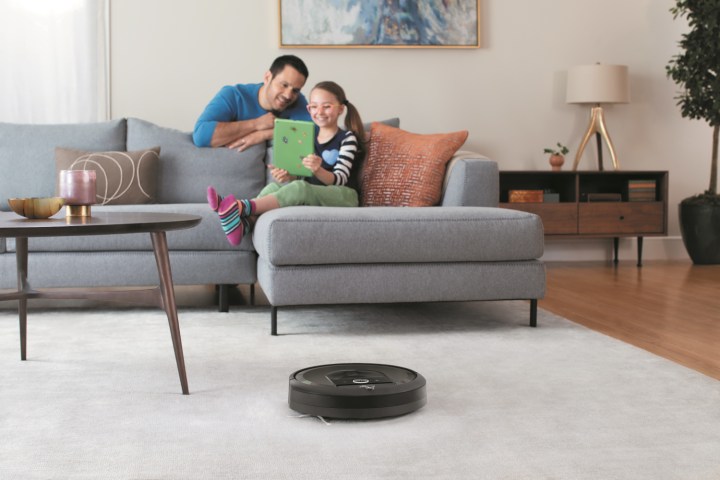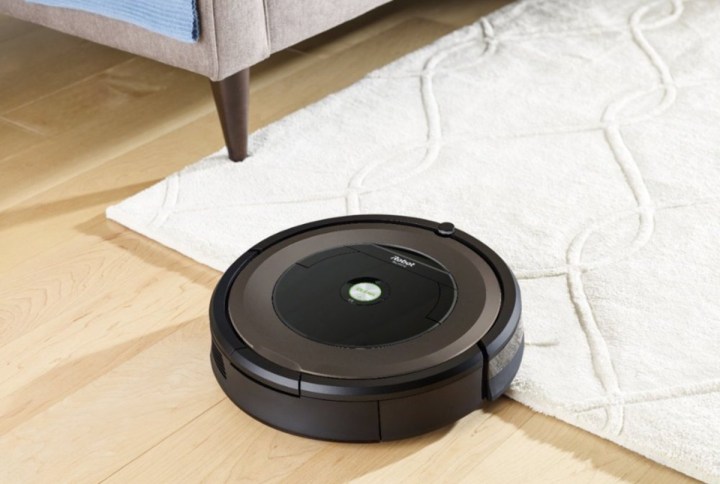Many of the pictures we see of Roombas and other robot vacuums in action have them scooting over hard flooring, clearing up pet kibble or dust bunnies. Images of the bots on carpets are rarer, although they exist, too. That leads to a lot of questions from first-time buyers. Can Roombas work on carpet? Do you need a different kind of robot vacuum just for carpet? Will carpet damage a Roomba if it’s not made for it?
Fortunately, most robot vacuums are made to work on carpet and hard flooring, although there are some exceptions. Let’s tackle these questions with an FAQ about how robot vacuums and carpets interact.

How do robot vacuums work on carpets?
Robot vacuums can function on carpets, especially low-profile carpets with low-pile height. Many models are created with automatically-adjusting cleaning heads or adjusting heights that can transition to carpet more easily and can even adjust suction between carpets and hard flooring for the best results.
Robot vacuums without those features may be able to handle carpets, but it’s not guaranteed. If you have a lot of carpeting in your home, always look for robot vacuums that mention they are made for carpets or have modes specifically for carpets.
Do Roombas clean carpets well?

Roombas come with edge brushes and rubber brushes that tend to work better on hard surfaces. After all, you don’t sweep your carpet. However, the rubber design of the bottom brush can help pick up debris on carpets, and the suction power of all robot vacuums can help suck up dust, dander, and dirt.
However, Roombas and other robovacs aren’t exactly large-scale vacuum cleaners. And while their suction can be powerful for their size, they may not be able to clean as deep down into your carpet as a full-scale vacuum with a powerful cleaning head. If you have embedded dirt or other debris that has sunk down into the pile of your carpet, a robot vacuum may not be able to handle it. That’s why it’s important to occasionally clean carpets with a larger vacuum as well.
How do I get a Roomba to move onto the carpet?
If the carpet has a low profile, it shouldn’t be a problem with Roombas that have automatic adjustment features. The robot vacuum will simply hop onto the carpet and keep on going. Sensors on Roombas are smart enough to avoid things like toys, shoes, and even pets that may be on the carpet while they work.
In many homes, the transition between hard flooring and carpet is minimal. However, if floor construction has led to a significant height difference in the surface, some robot vacuums may struggle. Today’s robot vacuums can overcome heights up to three-quarters of an inch, but if your carpet’s height is more than one-quarter inch or so, you should try to test a robot vacuum first (take a look at return options if ordering online) and ask an expert about a particular vacuum. Some vacuums will struggle more than others.
Do Roombas get stuck on rugs?

Rugs are different than carpets. They tend to be higher than carpets, they often have fringes that can confuse robot vacuums, and they are frequently shaggier than carpets, which make them difficult to clean.
In most cases, rugs are best handled with a traditional vacuum and/or a good shake outside. Roombas can usually handle low-profile rugs just fine, but sometimes they will automatically avoid rugs, sensing them as an obstacle. To avoid robot vacuums getting caught on rugs, you can set digital boundaries via the Roomba app (other robot vacuum apps may have this feature, but it’s not guaranteed).
Do robot vacuums work on thick carpets?
Higher-end Roombas can handle high-pile carpets, but other robot vacuums may not do as good of a job. Look for bots with powerful suction, dual turbines, or similar features that will perform well on thicker carpets. Once a carpet reaches shaggy or plush status, it’s too thick for a robot vacuum to tackle, so you’ll need to find other cleaning options.
Why is my Roomba avoiding my carpet?
As we mentioned above, higher, thicker rugs and carpets, especially those with fringe, may look like obstacles to your Roomba. In these cases, Roombas will go around carpets. However, there’s another important exception — black carpets or other very dark-colored carpets. These dark colors mess with many robot vacuum sensors. Robot vacs often read them as a potential falling hazard or another challenge and will refuse to go on the carpet even if it’s level with the rest of the floor.


